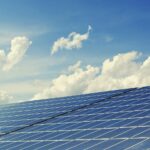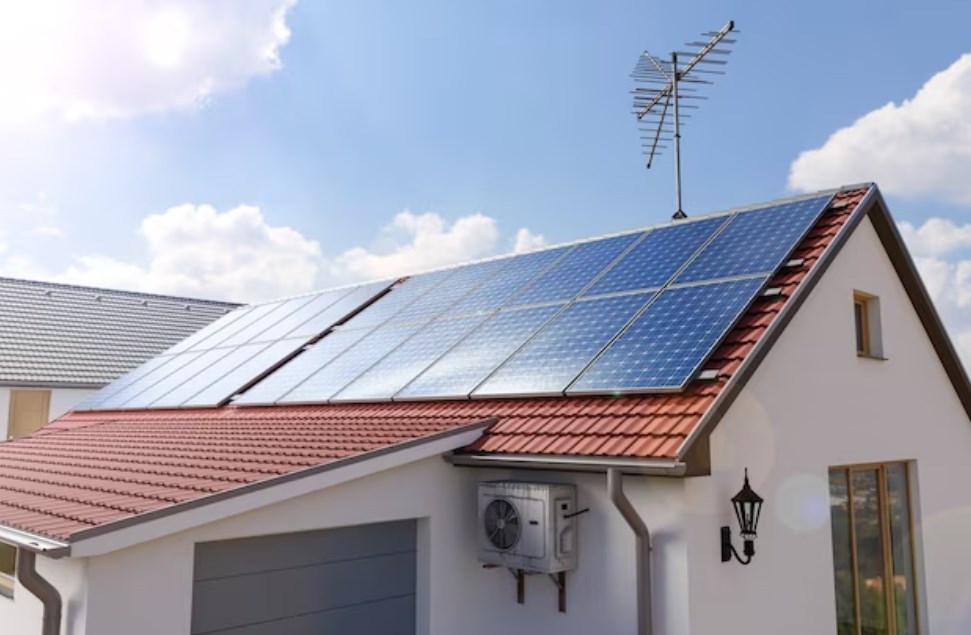A Guide to Using Solar Panels for Hot Water Heating Systems
Solar energy is increasingly becoming a preferred alternative source of power for many homeowners and businesses. A particular area where this green energy source has made a significant impact is in water heating. Utilizing solar panels (SPs) for hot water heaters not only provides an eco-friendly way to heat water but also reduces energy bills significantly.
In this comprehensive guide, readers will gain insights into the intricacies of solar-powered hot water systems, the number of SPs required, types, installation processes, and tips for optimal performance.
Table of Contents:
- Understanding Solar Panels and Their Importance;
- Applications of Solar Panels in Water Heating;
- Key Steps in Utilizing Solar Power in Electric Water Heaters;
- Active Solar Water Heating Systems: Types and Functions;
- Practical Tips for Installation and Maintenance;
- Passive Solar Water Heating Systems;
- How Many Solar Panels Are Required for a Hot Water Heating System?;
- How Much Energy Does a Solar Panel Produce in a Day?;
- Steps to Determine the Number of Solar Panels Needed;
- Energy Efficiency and Cost Savings;
- Installation and Maintenance;
- Assessing Your Needs and Options;
- Conclusion;
- FAQ.
Understanding Solar Panels and Their Importance
Solar energy capture devices, notably SPs, are instrumental in transforming sunlight into usable power, marking a pivotal step towards green energy solutions. These devices play a crucial role in mitigating environmental pollution, largely attributed to the consumption of non-renewable energy sources like fossil fuels.
<iframe width=”560″ height=”315″ src=”https://www.youtube.com/embed/PdyC-Dua-Zk?si=pGIrwjLgaW117MbV” title=”YouTube video player” frameborder=”0″ allow=”accelerometer; autoplay; clipboard-write; encrypted-media; gyroscope; picture-in-picture; web-share” allowfullscreen></iframe>
SPs, or photovoltaic cells, have become synonymous with clean and sustainable power generation. They are designed to absorb solar energy and convert it into electricity, making them ideal for a variety of applications including hot water heating systems, remote power needs, and more. The growing inclination towards solar energy is attributed to its cost-effectiveness, efficiency, and contribution to reducing carbon footprints.
Applications of SPs in Water Heating
The versatility of SPs is underscored by their adaptability to various uses, including domestic and commercial heating. Utilizing these panels in heating systems presents an eco-friendly and cost-saving alternative to conventional methods. In the realm of water heating, solar thermal systems have garnered popularity due to their efficiency and the cost savings they offer.
Solar thermal heating employs panels designed to absorb heat from the sun, facilitating the warming of water stored in adjacent tanks. This technology has found extensive application in residential settings, commercial establishments, and pools, marking a shift towards sustainable means of heating water. While the initial investment might be substantial, the long-term savings and reduced environmental impact make solar water heating a worthy consideration.
SPs designed for water heating are characterized by durability, requiring minimal maintenance to operate efficiently over the years. Several professional services specialize in the installation and upkeep of these systems, ensuring that households and businesses can effortlessly transition to this green technology.
Key Steps in Utilizing Solar Power in Electric Water Heaters
Implementing solar energy in electric water heating systems entails a combination of strategic planning and technology integration. These systems incorporate storage tanks and solar collectors, with the latter playing a critical role in harnessing and converting solar energy into heat. The subsequent sections will offer detailed insights into the number of SPs requisite for optimal performance and an in-depth look at the installation procedures.
It is essential to note the two prevalent types of solar thermal systems employed in domestic water heating – active and passive. Each comes with distinct operational mechanisms and benefits, with the choice largely influenced by climatic conditions, budgetary allocations, and specific heating requirements.
Active Solar Water Heating Systems: Types and Functions
Active solar water heating systems are distinguished by the inclusion of pumps and controls to facilitate the circulation of water or heating fluid. Two primary categories exist within this domain, the direct or open-loop and indirect circulating systems.
In direct circulating systems, pumps facilitate the movement of water through collectors and into the home. These systems are particularly suited for regions with warm climates, ensuring a consistent supply of hot water. On the other hand, indirect circulating systems incorporate a heat exchanger and non-freezing liquid to prevent freezing in colder climates.
Understanding the operational intricacies of these systems and their respective suitability can significantly influence the efficiency and effectiveness of solar-powered water heating installations. The following section delves into practical installation tips and maintenance practices essential for optimizing the performance of these green heating alternatives.
Practical Tips for Installation and Maintenance
Proper installation and maintenance are crucial in optimizing the performance and longevity of solar-powered water heating systems. It begins with the selection of quality SPs and components, ensuring that the system delivers optimal performance throughout its lifespan.
Some pivotal steps include the correct positioning of the SPs to maximize sunlight exposure, ensuring that the panels are free from obstructions, and conducting regular inspections to identify and address potential issues promptly.
Passive Solar Water Heating Systems
Passive solar water heating systems are celebrated for their reliability, cost-efficiency, and longevity. Although these systems might not offer the performance robustness of their active counterparts, they nonetheless are essential options for many homeowners. These systems are typified by their simplicity and low maintenance requirements, a feature that underscores their popularity.
- Integral Collector Storage Systems and Thermosiphon Systems are the primary categories of passive solar water heating arrangements. Integral Collector Storage Systems are characterized by their operational efficacy in regions where freezing temperatures are a rarity. These systems seamlessly integrate the collection and storage units, ensuring efficient heat transfer and retention;
- In contrast, Thermosiphon Systems operate on the principle of natural convection, where the density differential between hot and cold water facilitates circulation. For effective operation, strategic placement of the collector lower than the storage tank is paramount to ensure the natural flow of heated water into the storage unit. Expert installation is required to optimize system performance, ensuring the homeowners reap maximum benefits in terms of energy savings and operational efficiency.
How Many SPs Are Required for a Hot Water Heating System?
The incorporation of solar technology in heating water is a blend of environmental stewardness and economic prudence. However, determining the appropriate number of photovoltaic cells necessary to power a hot water system is paramount. A myriad of factors including the energy consumption of the heater, the efficiency of the photovoltaic cells, and the available installation space plays a pivotal role in this calculation.
For instance, a standard heating system consuming 1500 watts per hour would typically require three standard-sized photovoltaic cells. This is calculated based on the premise that solar cells are available in various capacities, with the common ratings being 100 watts and 300 watts.
The suitability of a home for the installation of photovoltaic cells is contingent upon several factors:
- Orientation of the Roof: A southward-facing roof is optimal as it ensures prolonged exposure to sunlight, essential for maximizing energy generation;
- Roof Space: An area of 2-5 square meters is essential to house the cells while ensuring optimal exposure to sunlight;
- Shade Analysis: The installation site should be free from obstructions such as trees or neighboring structures that could cast shadows and impede sunlight exposure.
How Much Energy Does an SP Produce in a Day?
Energy production from photovoltaic cells is contingent upon a constellation of factors, with sunlight availability, panel size, and efficiency being paramount. The correlation between the intensity and duration of sunlight exposure and energy production is direct. Consequently, solar cells are more productive during sunny days compared to overcast or rainy days.
The dimension of the photovoltaic cells also directly influences their energy output. Larger cells have increased surface areas for sunlight exposure, translating to enhanced energy production. Furthermore, technological advancements have exponentially enhanced the efficiency of solar cells. The contemporary cells boast an efficiency rating of up to 25%, a significant leap from the initial 6%.
To calculate the energy needs and the associated costs, one must evaluate the efficiency of the chosen solar cells, the available installation space, and the daily energy consumption needs of the hot water system. Specialized firms, such as Everything Solar, offer consultancy services to prospective solar energy users, providing tailored solutions based on individual needs and premises’ specifications.
Steps to Determine the Number of Solar Panels Needed
Deciding the number of photovoltaic modules needed for a hot water system requires a systematic approach. Initially, evaluating the energy consumption of the heating system is critical. This is followed by an assessment of the efficiency and output capacity of the available photovoltaic modules.
- A comprehensive analysis of the installation space, including the roof’s orientation, area, and potential obstructions, is then conducted. This evaluation ensures the chosen photovoltaic modules are appropriately sized and positioned to maximize energy generation;
- The energy output of a photovoltaic module is directly related to its efficiency and size. Consequently, larger, more efficient modules are preferable, especially for homeowners with limited roof space. These modules not only maximize energy generation but also optimize the available installation space.
Determining the appropriate number of photovoltaic modules for a hot water system is a multifaceted process. It involves a thorough evaluation of the heating system’s energy needs, the efficiency and capacity of the available photovoltaic modules, and the suitability of the installation space.
By meticulously considering these factors, homeowners can optimize their investment in solar technology, ensuring not only significant savings on energy bills but also a reduction in greenhouse gas emissions.
Energy Efficiency and Cost Savings
Understanding the Implications of Solar Water Heaters on Energy Conservation and Financial Efficiency:
Solar water heating systems have proven to be instrumental in reducing energy consumption and curtailing utility bills. Their integration into residential and commercial spaces signifies a stride towards sustainability and energy independence. Here are key considerations:
- Energy Efficiency:
- Minimal Operational Costs: Unlike conventional systems, solar water heaters have low maintenance and operational costs;
- Energy Independence: These systems reduce reliance on grid electricity, offering energy security;
- Peak Performance: Solar heaters provide optimal performance during peak sunlight, reducing the load on the electricity grid.
- Environmental Impact:
- Emission Reduction: Solar heating systems contribute significantly to the reduction of greenhouse gas emissions;
- Renewable Source: They utilize solar energy, an inexhaustible and clean energy source.
- Financial Considerations:
- Long-term Savings: Despite the initial investment, the long-term savings on utility bills are substantial;
- Incentives and Rebates: Various regions offer incentives for the installation of solar heating systems, reducing the financial burden.
Installation and Maintenance
The process of installing and maintaining solar water heaters is intricate but crucial for optimal performance and longevity. Professional installation ensures the system’s efficiency, while regular maintenance guarantees sustained performance. Critical aspects include the appropriate placement of solar collectors, regular inspections, and timely repairs.
The orientation and angle of solar collectors are vital to maximize solar energy absorption. Professionals consider geographical location and climatic conditions to optimize the system’s energy capture capacity. Moreover, a detailed inspection regime, including checking for leaks, ensuring the integrity of the insulation, and evaluating the system’s overall performance, is fundamental.
Assessing Your Needs and Options
Before transitioning to a solar water heating system, a comprehensive assessment of the specific needs, available options, and potential benefits is crucial. Key factors include evaluating the premises’ solar energy potential, the heating requirements, and the financial implications.
Understanding the nuances of various solar water heating systems, their operational efficiency, and maintenance needs is essential. Prospective users should also consider the climatic conditions, as they significantly impact the system’s performance and energy output.
Conclusion
In the quest for sustainable energy solutions, solar water heaters emerge as a pivotal asset, amalgamating economic efficiency and environmental conservation. The initial investment is offset by substantial savings on energy bills and a reduced environmental footprint. They exemplify the synergy between technological advancement and ecological preservation, a hallmark of sustainable development.
Each aspect, from the diversity in solar heating systems and their operational nuances to the financial and environmental implications, underscores the multifaceted benefits of this technology. As global consciousness shifts towards sustainable energy practices, the integration of solar water heaters is not just a contemporary trend but a forward stride towards an eco-friendly future.
FAQ
Solar water heating systems may entail a significant initial investment, but the long-term savings on energy bills and the environmental benefits make them a valuable asset. They provide an eco-friendly and cost-effective alternative to traditional heating systems, enabling users to enjoy extended hot water supply without incremental cost implications.
Absolutely. SPs equipped with photovoltaic cells capture solar energy and transform it into thermal energy. This energy can be directly utilized or stored for heating water, offering an environmentally friendly and cost-saving solution.
For a heating appliance with a 1500W rating, fifteen 100W solar modules would be needed for optimal performance. However, this number decreases with an increase in the wattage of the individual modules.
Yes, a distinct solar hot water system is essential even if SPs are already installed. These specialized systems are engineered to efficiently heat and store water, maximizing energy utilization.
Yes, depending on the capacity and wattage of the solar modules, multiple heating appliances can be powered simultaneously. However, a thorough assessment of the energy requirements is essential to ensure optimal performance.
Incorporating a battery in the solar power setup is highly recommended. It ensures continuous power supply, enhancing the system’s reliability, especially during periods of low sunlight.








